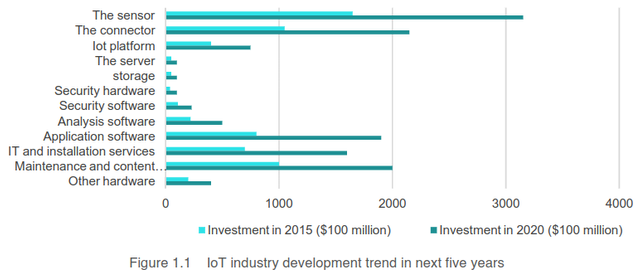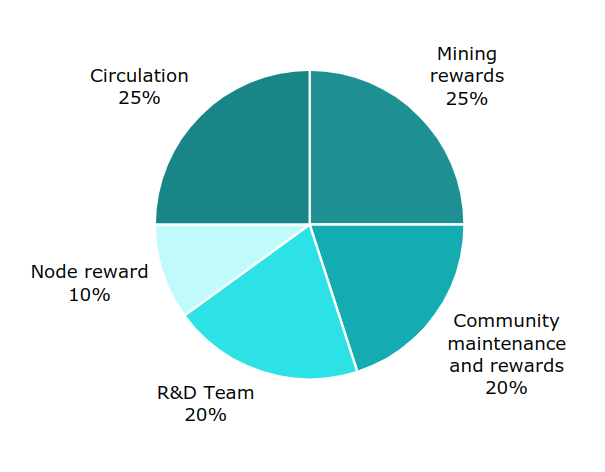1.- Introduction
2.- Problems of modern IoT solutions
2.1.- Most systems are not cross-platform
2.2.- Little data security and privacy protection
2.3.- Centralized cloud computing is relatively slow
2.4.- Business model is still unclear
3.- How IONChain solves these problems
3.1.- IONChain is crossplatform - One device, One code, One coin
3.2.- Edge computing offers security and speed
3.3.- Economic model - IONC token
4.- IONIZATION algorithm - separating value creation and transfer
4.1- Creation of value
4.2- Transfer of value
5.- Use cases
5.1.- General use cases
5.2.- Use case #1 - individual
5.3.- Use case #2 - business
6.- Project roadmap
7.- The team
8.- Contact information

Up until the beginning of 18th century, everything was hand-made. People used to make goods in manufactures by hand, which required lots of work and time; also, mass production was impossible, because there was no way of speeding up the production without losing the quality. Economy even in the most advanced countries was at ludicrous by today's standarts levels.
Then came the middle of 18th century, which marked the beginning of one of the most important advances in the history of humankind: The Industrial Revolution. During the Industrial Revolution, the world begun mass-producing different goods, which lead to reduction of their prices. The global economy skyrocketed.

What had lead to such a sudden change? The answer is simple: automatisation. No longer had people to make things themselves: huge iron machines produced them. Factories created the world we are living in.
Now, a similar change must occur in the way we use domestic appliances. IoT is the technology that will help it occur. Right now IoT is one of the fastest growing industries:

The only problem is that as for now, there is no reliable technology to control different IoT devices and connect them into a single, well-functioning network.
This is where the IONChain comes to help. Using blockchain technology, it allows seamless transfer of value between a various range of IoT devices, each acting as a node, thus creating a reliable, fast and secure IoT chain management solution.

2.1.- Most systems are not cross-platform
If the data cannot circulate freely between the IoT devices, there is little to no value in such a system. Centralization leads to creation of the barriers for value flow in form of different kind of bottlenecks, such as computational power of central server.
2.2.- Little data security and privacy protection
Existing IoT systems are centralized. That means that:
*User does not know how information provided by his IoT devices can be used;
*It is possible to use the data to determine activity by user or even business;
*A hacker attack is possible, because all of the data is stored on a single server (there have been such attacks recently).
2.3.- Centralized cloud computing is relatively slow
There are several bottlenecks in a performance of a centralized system, such as server's computational power and network bandwidth. This can lead to comparatively large delays (up to hundreds of milliseconds) which can be crucial in several IoT field. For example, self-driving cars or VR gadgets cannot function properly with such big delays.
2.4.- Business model is still unclear
As for now, no large scale business uses large amounts of data generated by IoT devices. The only way large businesses have benefitted from IoT until now is enhanced performance of electronics.

3.1.- IONChain is crossplatform - One device, One code, One coin
The single blockchain solution where every device can act as a node ensures that IONChain is crossplatform.
Each device acts both as a node and a mining machine, ensuring that the Data Quality Proof Consensus and Time Lapse Proof Consensus can function. Both aforementioned algorithms calculate the contribution of every device, evaluating factors such as data quality, quantity and the role of device. This is what One device stands for.
Each of the devices has its own unique identification code. This is what One code stands for.
IONChain has its own token, IONC, functions of which I will describe later. This is what One coin stands for.
3.2.- Edge computing offers security and speed
The use of edge computing instead of a single centralized server provides all the decentralization advantages, including higher speed and better security.

Faster speeds allow IoT to create new IoT usage scenarios that were impossible before because of the limited speed and high latency. A good example of such scenario would be autonomous vehicles using V2V (vehicle-to-vehicle), V2G (vehicle-to-grid) and V2X (vehicle-to-everything) systems. Such a system cannot function without high response times, which IONChain provides.
Better security encourages more businesses to start using IoT solutions, which creates higher demand for public IoT blockchains, such as IONChain. IONChain offers security, which, in turn, increases its value.
Both these advantages of IONChain will attract new customers to IoT field, speeding up mass adoption.
3.3.- Economic model - IONC token
What is IONC token and what is its commercial value?
IONC token is the official token of IONChain platform. It is also a key element of IONChain's economic model.
Facts:
Maximum supply: 800 million coins
Release period: during 20 years (Note: after this period, a committee elected by IONChain users will decide if the issue of additional tokens is necessary)
The commercial value of IONC token is based on its role in ecosystem.
Here are examples of uses of IONC token in IONChain blockchain:
- Rewards for individual IoT devices acting as a miners
- Covering the cost of R&D expenses of IONChain Foundation
- Transaction fees
- Fuel for running dApps, with node on which dApp is being run receiving reward
- Rewards for nodes allowing IoT devices to communicate
- Other use cases can be found on page 30 of IONChain Whitepaper
IONC token distribution


While being successful elsewhere in cryptocurrency sphere, algorithms that combine value creation with value transfer are not well-suited for IoT. IONChain addresses this problem by using IONIZATION - an algorithm that separates value creation from value transfer.
4.1- Creation of value
The value is created by every IoT device in the system.
It consists of 4 steps:
- Value generation
- Value verification
- Value evaluation
- Value confirmation
4.2- Transfer of value
Transfer of value happens with the help of IONChain edge computing solution - IONChain Fog Computing.
Value transfer part consists of six layers:
- Application layer
- Service layer
- Protocol layer
- Smart contract layer
- Blockchain layer
- Data storage layer
4.3.- General IONChain architecture
It can be seen how different parts of IONChain architecture work together from the scheme below:


5.1.- General use cases
Thanks to great performance and security, IONChain can be used in a wide range of scenarios in different industries:

5.2.- Use case #1 - individual
Every Larry's workday morning is similar. He used to waste lots of time on the routine activities. Larry turned off alarm clock every day, then turned on his boiler so that he could take shower, turned on the kettle and toaster, TV and so on. His morning mainly consisted of turning on and off gadgets.
Until now.
Recently, Larry bought many 'smart' gadgets, such as smart TV, smart kettle and smart boiler. Using IONChain solution, he connected all of his IoT devices into one single system.
Now, Larry still turns off his alarm clock every day. But the boiler turns on itself automatically, because the system knows Larry's pattern of action. So does the kettle. And the TV. Now, instead of wasting his time on routine activities in the morning, Larry can relax and read news while IONChain does them instead of him.
5.3.- Use case #2 - business
SmartXpressDelivery is a logistics company. Each day, it has to process large amounts of data about parcel destination, weight, etc. In the past several years, their growth has been limited by the low computational power of their central server. The company used to spend lots of money on electricity needed to power the server and constantly upgrading it with costly parts.
Thanks to IONChain though, their situation has changed noticeably. Now, with the use of edge computing solution from IONChain, there is no need in powerful server. Electricity bills have reduced significantly; what's more, now the data transfer speeds are faster and the company is no longer limited by the computational power of their server. Now, SmartXpressDelivery continues to grow thanks to IONChain.







This post has been submitted for the @OriginalWorks Sponsored Writing Contest!
You can also follow @contestbot to be notified of future contests!
Downvoting a post can decrease pending rewards and make it less visible. Common reasons:
Submit
Hi @alexanderrigov!
Your post was upvoted by @steem-ua, new Steem dApp, using UserAuthority for algorithmic post curation!
Your UA account score is currently 0.000 which ranks you at #147367 across all Steem accounts.
Your rank has improved 918 places in the last three days (old rank 148285).
In our last Algorithmic Curation Round, consisting of 306 contributions, your post is ranked at #242.
Evaluation of your UA score:
Feel free to join our @steem-ua Discord server
Downvoting a post can decrease pending rewards and make it less visible. Common reasons:
Submit
Congratulations! This post has been upvoted from the communal account, @minnowsupport, by alexanderrigov from the Minnow Support Project. It's a witness project run by aggroed, ausbitbank, teamsteem, someguy123, neoxian, followbtcnews, and netuoso. The goal is to help Steemit grow by supporting Minnows. Please find us at the Peace, Abundance, and Liberty Network (PALnet) Discord Channel. It's a completely public and open space to all members of the Steemit community who voluntarily choose to be there.
If you would like to delegate to the Minnow Support Project you can do so by clicking on the following links: 50SP, 100SP, 250SP, 500SP, 1000SP, 5000SP.
Be sure to leave at least 50SP undelegated on your account.
Downvoting a post can decrease pending rewards and make it less visible. Common reasons:
Submit